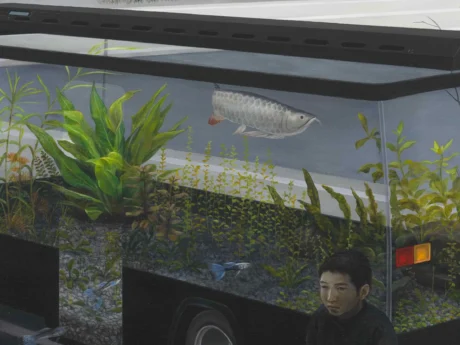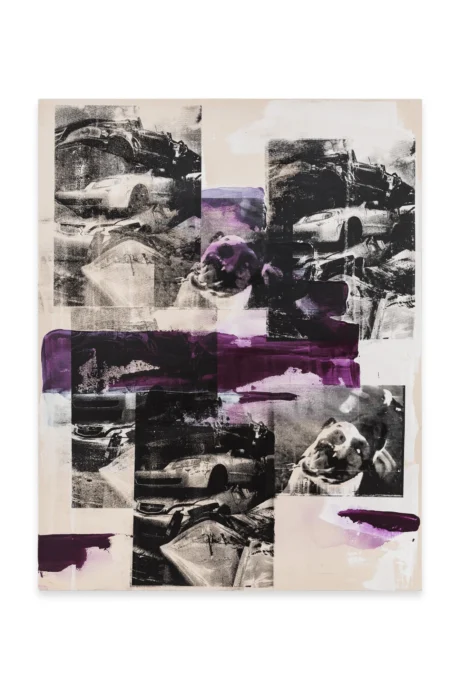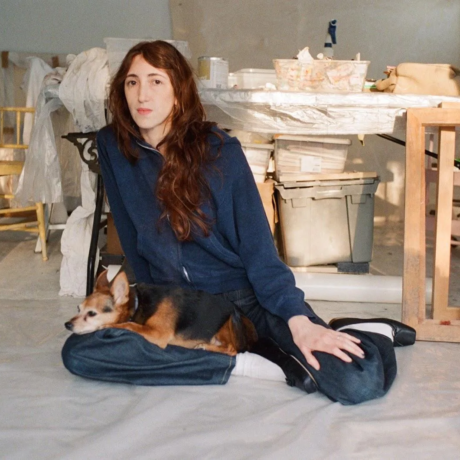Can humans give up control of the ecosystems they claim to love, or is their bond to Mother Earth innately rooted in their right to dominate her? Four artists weigh in.
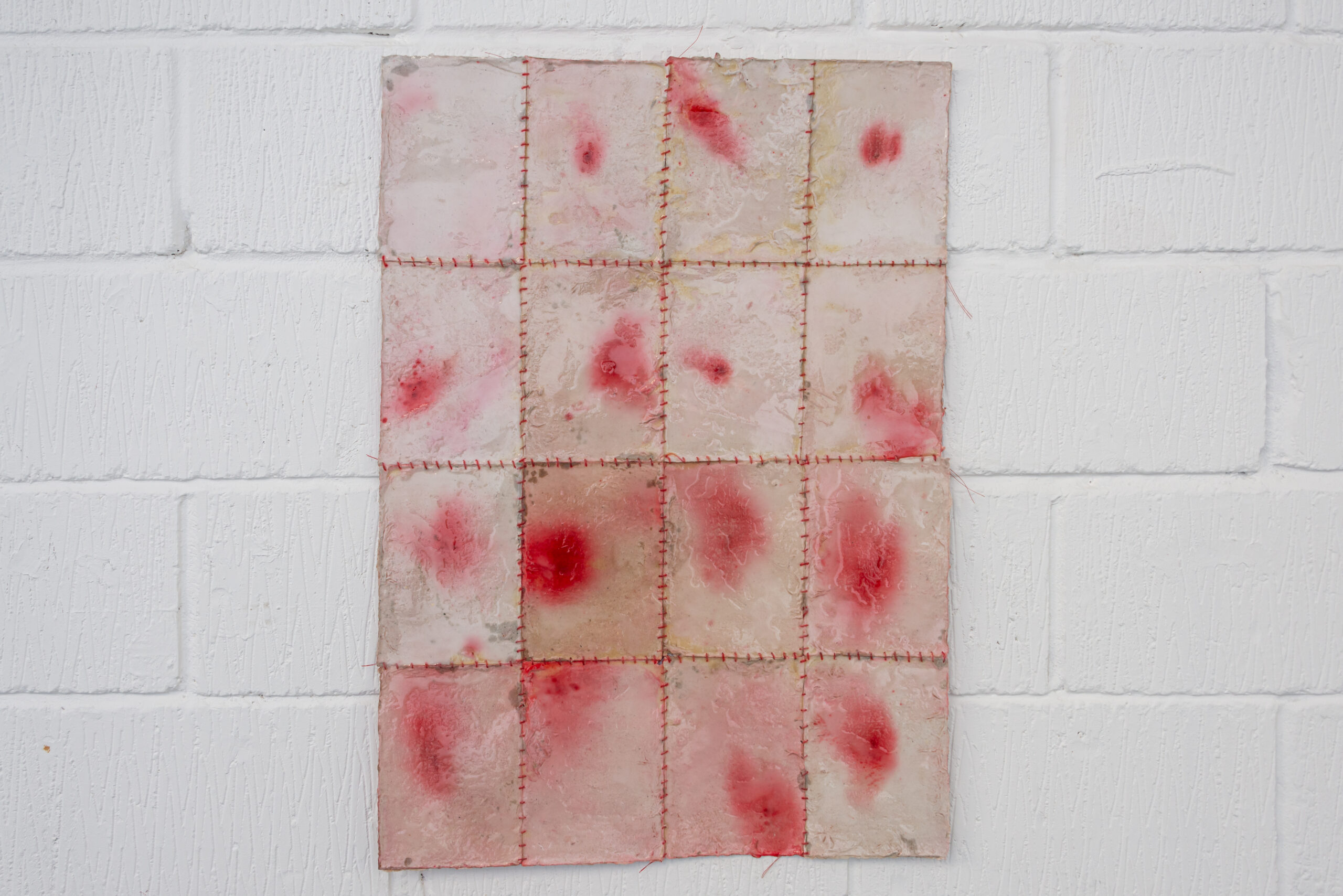
According to the World Population Review, 8,005,176,000 is the number of people living on Earth at 4:33 pm CET on 7 December 2023, the precise moment I set about writing this article. With an estimated 140 new births per minute, adding up to the inhabitants already existing on the planet, this total is only bound to get exponentially larger as I reach the end of this feature, even greater as you gradually work your way through it. When I look at those figures, it feels hard to visualise how over eight billion human beings may have the chance to carve themselves into a place of their own against the 148,900,000 m2 surface of our life-harbouring home. If my maths is correct, that would leave less than 0.02 square metres per citizen of the world — a dramatic realisation made even more appalling if we consider that about 10 percent of terrestrial land remains untouched by any human activity to this day.
Now, picture the impact of nearly 10 billion people breathing, moving around, and exploiting the Earth’s resources to survive. The fact that we have just endured the hottest summer ever registered since 1880 will suddenly feel like a self-inflicted wound. Yet, not even the recurring wildfires, destructive floods, and steadily rising temperatures appear to be enough to persuade us to act against the rapid decay of our resilient, forgiving Mother. Just like a dog chasing its own tail, the non-stop campaigning of climate activists will be in vain unless backed up by concrete environmental regulations and structural interventions aimed at tackling the emergency before it is too late. As the post-COVID-19 era continues to witness a growing number of urban dwellers abandoning the city in favour of the rural countryside in nations including the UK, the US and Germany, two questions arise spontaneously: why do we expect nature to grant us a better life when she can’t expect the same of us? And what makes us think it is fair to anthropise her so she can meet our fleeting whims? Launched at ZÉRUÌ, London, on 24 November, Bloody Lipstick, Blooming Dirt is the group show exposing our toxic love affair with the planet in search of answers to the dilemmas of our times.
Gathering artworks by Henry Kitcher, Meryl Yana and Aléa, the artist duo composed of Stella Lee Prowse and Miriam Josi, the exhibition condemns humans’ tendency to mould the world so that it fits their expectations of it at the cost of irremediably compromising its ecosystems. Despite leveraging three radically different approaches, these creatives “delve into the underlying notion of control that rules our relationship with the natural environment and its aesthetic”, reads a statement released ahead of the opening of the exhibition. Embracing the organic materialness of the reality around us, Bloody Lipstick, Blooming Dirt is a satirical play on the spiralling consequences of the Anthropocene, an era whose pace is set by non-stop, almost pathological industrial production and consumption, man-caused biodiversity loss and the resulting ecological damages.
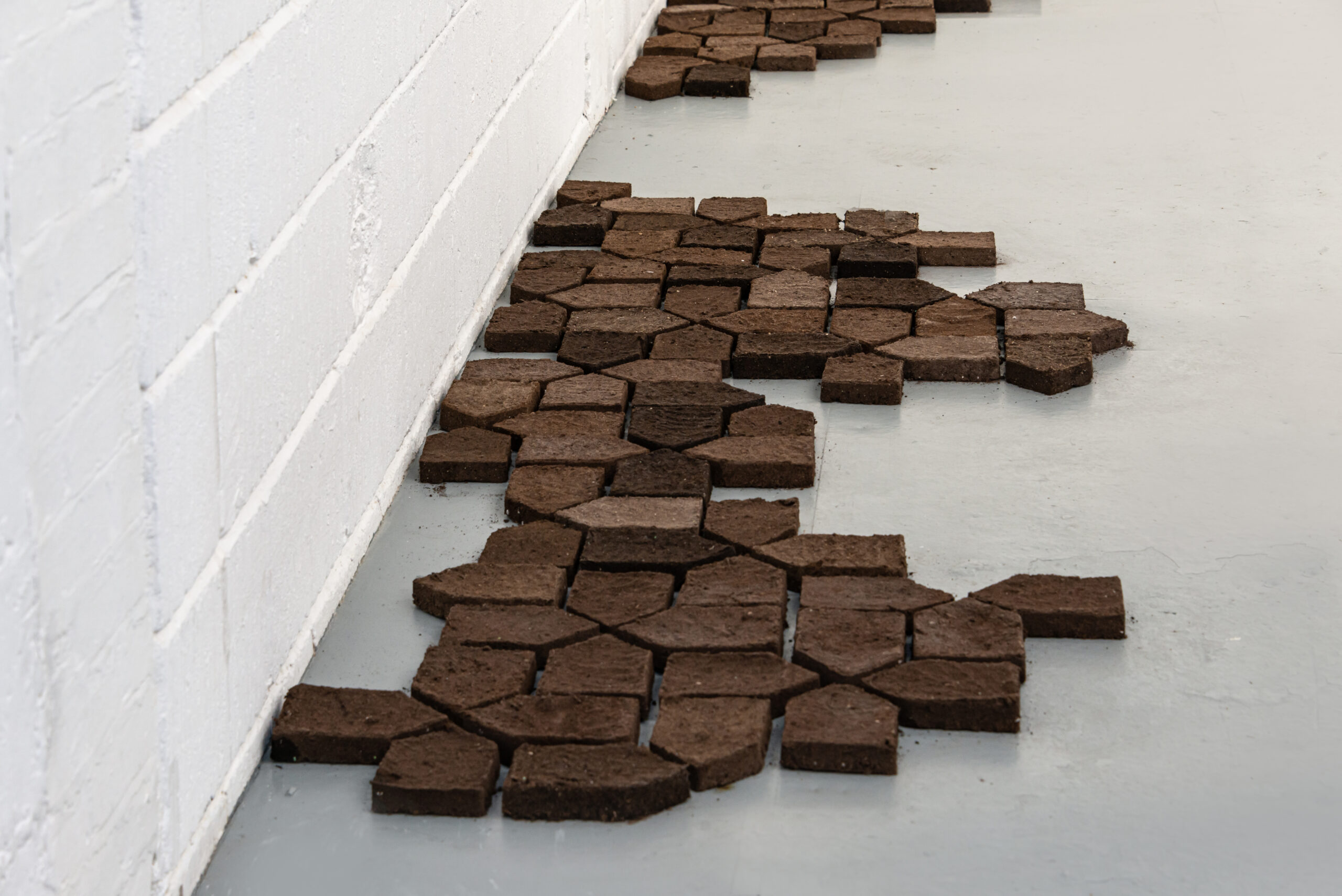
With the bizarre trend of ‘lawn paint’ — or the increasingly profitable practice of spray-painting dry patches of greenery to restore their original lushness in drought scenarios — as its case study, the group show not only strives to cast light on the tragedy of climate change, but it also focuses on turning the power dynamics shaping the unequal interaction between humans and the Earth on their heads. How? By creating the conditions for different natural forces and organisms to intervene directly in the artistic output of this collective initiative and alter it outside of any human-enforced constraints. Starting from a reflection on the ground beneath us and the imperceptible value it holds for our lives — without soil, there would be no food on our plates nor drinkable water, as besides stocking most of the carbon dioxide present in the atmosphere, it also births the resources necessary for our survival — Kitcher’s in-situ installation Ebb and Flow (2023) is profoundly symptomatic of our obsession with forcing dirt (and nature as a whole) into structures our species can, somehow, benefit from.
Composed of a series of compressed-soil bricks inspired by traditional English pavings, the London-based artist’s latest piece is a physical Tetris designed through a compulsive pairing process reminiscent of assembly-line production methods. Emerging from his observation of the colliding of the natural world and urban environments, Kitcher’s practice searches for a commonplace highlighting the points of contact between seemingly unrelated realities while simultaneously investigating their discrepancies. In his contribution to Bloody Lipstick, Blooming Dirt, he draws on the function-oriented manufacture of landscapes to criticise the way in which our infrastructures reduce the Earth’s elements to basic components of the artificial puzzle that is contemporary society.

If Kitcher’s Ebb and Flow stresses the denaturalisation to which soil is subjected, implicitly raising awareness of the suppression of the once thriving microbes nestled in it, design and material research studio Aléa’s experimental artwork BTD N.1 (2023) brings the vital ever-renovating energy of nature to the fore. Produced on-site, this unconventional installation sees grey oyster mushrooms sprout from shredded paper towers coated in mycelium — a network of fungal threads. Placed on a mound of dirt, it isn’t a coincidence if BTD N.1 serves as the centrepiece of the exhibition. With its mushrooms growing and transforming throughout the duration of the showcase, potentially leading to a revised pathway for visitors should those expand over the floor, the installation acts as a reminder of nature’s ability to regenerate itself against all odds. Traditionally, “the myco-fabrication process takes place in sterile labs to prevent contamination”, explains the organisers of the event, which is co-curated by Indira Béraud and Marco Galvan. Heightening the sensorial feel of Bloody Lipstick, Blooming Dirt, “the duo opts for a ‘dirty’ approach, letting mycelium thrive spontaneously in the ground rather than confining it in plastic moulds”.
But if there is a series of artworks on display at ZÉRUÌ that speaks to our twisted coexistence with the Earth, that must be French artist Meryl Yana’s weather-affected collection of paintings. Conceived in such a way so as to mimic the occasional bruising and wrinkling characteristic of skin and its uneven texture, this series presents viewers with what feels like a nuanced exploration of both human and planetarian frailty. Realised on paper using hues of carmine-red pigment from Morocco, Yana’s visceral, paint-encrusted pieces appear to envision the traumas, whether physical or metaphorical, forced onto the planet by our species’ inability to tend its precious, already compromised balance. Made by the talent herself, these papers are then exposed to the external environment through rainfall and winds before being let to dry in the sun. Emerging as a direct result of this “slow temporality of creation” are lacerations that, crisscrossing the source material, stand as a testament to nature’s sculpting power.
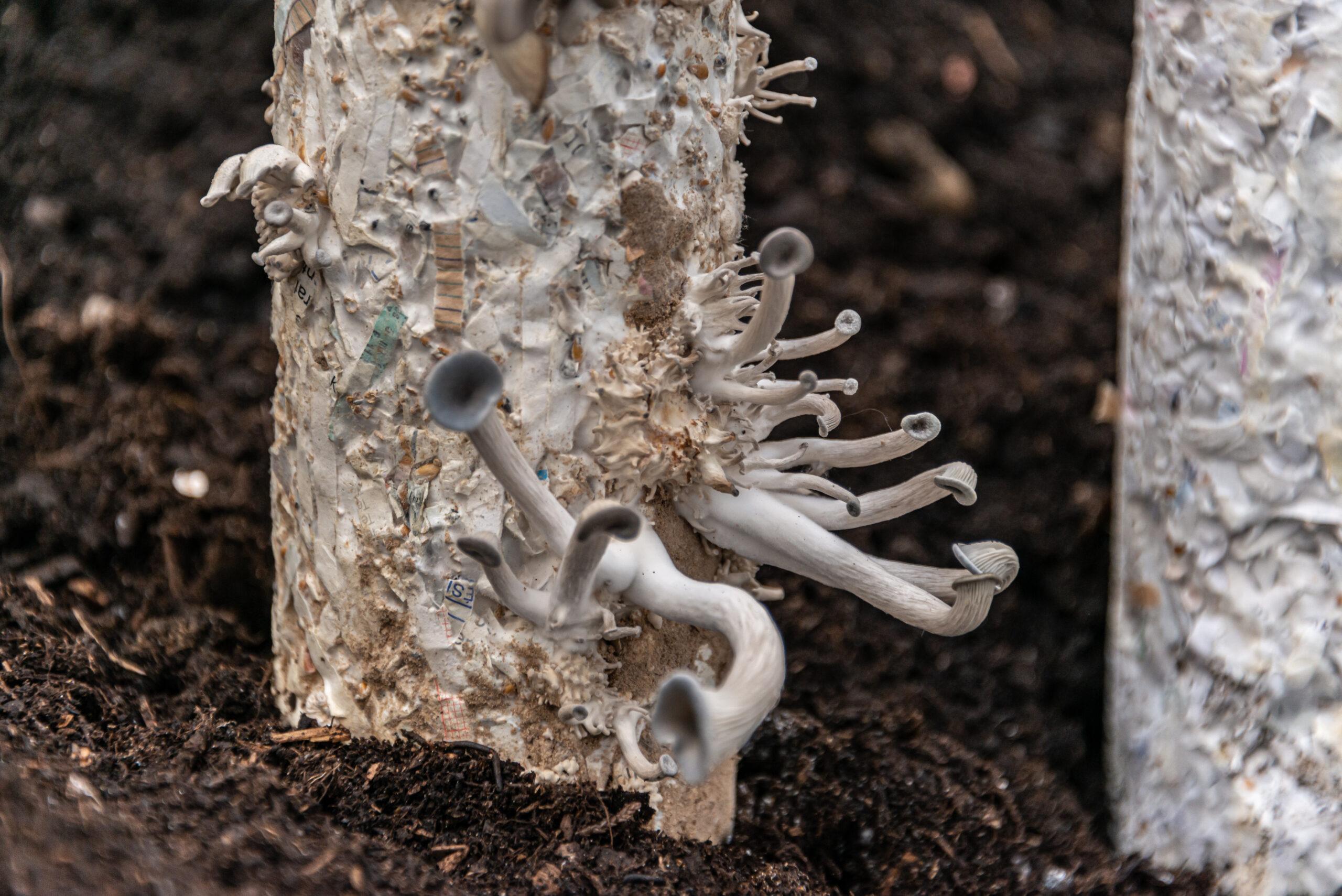
While hinting at the detrimental impact that the anthropisation of the world has had on its previously pristine natural reserves and habitats, Yana’s ingenious body of work scrutinises this hurt from an ambivalent, reciprocal perspective. Similarly to the title of one of her blood-shaded paintings, Recognising the wounds in each other, this whole collection translates the mutual injuries experienced by both humanity and our inhabited planet into artworks that call for a paradigm shift. Just like in every other toxic relationship, humans’ ties to the Earth seem to sink their roots into our restriction of her innate way of being and in our self-proclaimed right to exert control over her, significantly reducing her freedom to propagate, prosper and follow her ingrained cycles for no one’s but our own sake. As the worsening of the environmental emergency leads the natural realm to rebel against our arbitrarily imposed boundaries and fight back, the initial harm done to it morphs into a boomerang finding its way back to humans themselves. It is a process manifesting itself daily in the ecological disasters, abrupt temperature changes and severe weather conditions that are currently rewriting the history of humankind as we speak.
Conceptualised as a landscape of oxymorons or a symbolic space juxtaposing apparently contradictory terms — like with the words Bloody Lipstick, Blooming Dirt — or phenomena, this exhibition engages with this interplay of tensions first-hand to spark constructive awakenings. As its curators put it, some of the artworks on view “recount a relationship that is both commercial and objectifying, where the object’s purpose dominates the process of fabrication. Others, on the contrary, aim to activate and celebrate the agency of the raw material, rendering it fully visible”. Uniting each and every piece presented at ZÉRUÌ is the difficult realisation that, while flowers might still bloom through dirt whose composition has been altered by human activity, there is no shortcut nor beaten track to our survival that doesn’t presuppose the preservation of the planet in its fit-for-human conditions. With that premise in mind, the future remains in our hands. Whether it will blossom new life or fold onto itself is something only time will be able to tell.
Words by Gilda Bruno

